A Brief History
Discover the ancient origins and fascinating history of tea!
Tea is the most widely used ancient beverage in the world. Today, tea remains to be a popular drink of choice - helping us to hydrate, stay warm on a cold day or simply enjoy the taste of its different varieties. Alongside Black tea there are other tea varieties that we can also enjoy. Here are some facts about some of these:
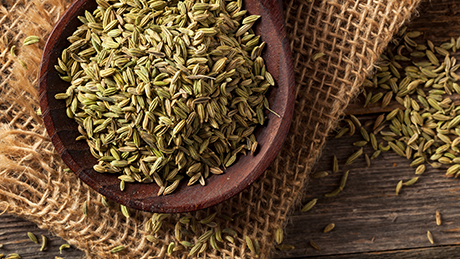
LATIN NAME: Foeniculum vulgare Mill
FAMILY: Apiaceae (celery family)
COMMON NAMES: Fennel fruit (seed), bitter fennel, sweet fennel
PART USED: Fruit (seed) - prepared from crushed or ground fennel seed.
KEY COMSTITUENTS: Essential oil containing mainly anethole and fenchole (<7.5% combined), estragole (<5%) alpha-pinene, limonene, camphene, p-cymene, beta-pinene, beta-myrcene, alpha-phellandrene, sabinene, y-terpinene and terpinolene.
Fennel is a sweet-smelling perennial herb with yellow flowers which is native to the Mediterranean but is now found all around the world. Fennel seeds from which the tea is derived contain essential oil, the main constituents of which are anethole and fenchole. Fennel seed tea has a liquorice-like taste and is similar in taste and appearance to anise tea.
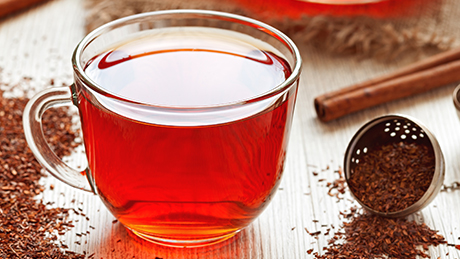
LATIN NAME: Aspalathus linearis (N.L.Burm.) R.Dahlgr
FAMILY: Fabaceae (pea family)
COMMON NAMES: Rooibos, rooibosch, red bush, bush tea, red bush tea
PART USED: Whole leaf and stem
KEY CONSTITUENTS: Polyphenols; dihydrochalcones; flavonoids (including Aspalathin, quercetin, dihydro-orientin and dihydro-iso-orientin); the processed leaves and stems contain benzoic and cinnamic acids, and nothofagin.
Rooibos is a shrubby legume that grows up to about five feet in height. It has a stem from which needle-like leaves grow from about one foot from the ground. Rooibos is a member of the legume, or pea, family and native to the mountain slopes of western Cape Province, South Africa.1
The leaves and stems are harvested in the summer and can be used to make tea in two different ways. Firstly, the leaves and stems can be cut, bruised and aerated (formally though inaccurately called ‘fermented’) or immediately dried to prevent oxidation. The oxidised type is called red tea because of its colour, while the non-oxidised type which contains more of the health promoting polyphenols is green in colour and called green rooibos tea (should be distinguished from ordinary green tea).
The traditional oxidised tea is processed today in much the same way as the indigenous people processed it hundreds of years ago, including the sun-drying step, but the tools are more sophisticated now.
Rooibos tea is caffeine free, low in tannins, high in vitamin C and bursting with flavonoid antioxidants and other helpful plant compounds including Aspalathin which is typically not found in other plants.2
It has been popular in southern Africa for generations and is now enjoyed around the world. Rooibos is brewed in the same manner as black tea and can be drunk with milk and sugar to taste, or with a slice of lemon and/or sweetened with honey.
1 Standley L, Winterton P, Marnewick JL et al. Influence of processing stages on antimutagenic and antioxidant potentials of rooibos tea. J Agric Food Chem. 2001;49(1):114-7.
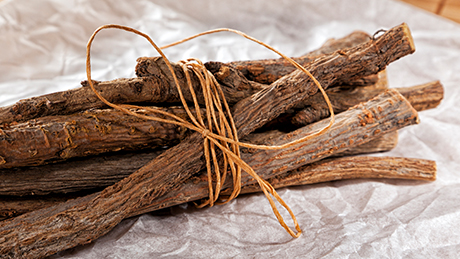
Liquorice is a member of the legume family which is native to southern Europe, India and parts of Asia.
Although its distinctive flavour is similar to that of anise or fennel the plants are not related botanically, but some products described as liquorice have been found to contain anise, instead, Liquorice tea is made from the root and stolon.
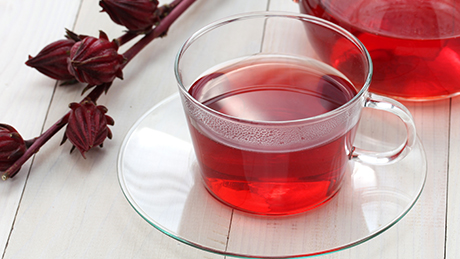
LATIN NAME: Hibiscus sabdariffa L
FAMILY: Malvaceae (mallow family)
COMMON NAMES: Roselle, Rosella, agua de Jamaica, flor de Jamaica, sorrel, red sorrel, Jamaica, hibiscus tea, agua de Jamaica, karkade, sour-sour.
PART USED: Calyx (flowers)
KEY CONSTITUENTS: ascorbic acid (vitamin C) (variable amounts); 15-30% w/w organic acids (citric, malic and tartaric acids); acidic polysaccharides; flavonoid glycosides (anthocyanins) e.g. cyanidin, gossypetin, hibiscin, hibiscitrin, hibiscetin, sabdaretin (major); delphinidin, chrysanthenin, myrtillin (minor); polyphenols, such as protocatechuic acid; and alkaloids such as daphniphylline.
There are several hundred species of hibiscus, a bushy annual plant in the mallow family, but the tea is made from the crimson or deep magenta-coloured calyces (sepals) of the Hibiscus sabdariffa flower. Hibiscus tea is sometimes referred to as ‘sour tea’1 due to the high concentration of acids. It has a distinct red colour and a tart lemony taste. Some people describe it as having a cranberry flavor. It can be consumed hot or cold.
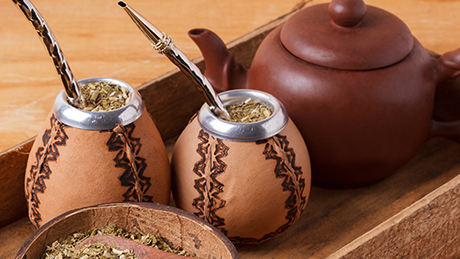
LATIN NAME: Ilex paraguariensis A. St. Hil
FAMILY: Aquafoliaceae (holly family)
COMMON NAMES: Yerba mate, yerva mate, maté, Paraguay tea, St Bartholomew’s tea, Jesuit’s tea, ilex, hervea, guyaki, chimarrão, cimmaron.
PART USED: Leaf (dried) and tender stems.
KEY CONSTITUENTS: flavonoids (quercetin, kaempferol and rutin); polyphenols (particularly caffeoyl derivatives); xanthine alkaloids (caffeine (0.7-1.7% w/w), theobromine (0.3-0.9%) and theophylline (absent or trace); saponins; minerals such as potassium, manganese and magnesium.
Yerba mate is made from the leaves of the Argentinian holy bush and according to the Pasteur Institute in Paris it contains almost all the vitamins necessary to sustain life.1 It is traditionally consumed in the countries of central and South America. Maté traditionally comes in three forms, green (unprocessed typically drunk in Argentina), partially roasted and fully roasted (typically drunk in Brazil). The flavours range from bitter herbaceous in green to very smoky and rounded in the fully roasted versions. Fans say it has the strength of coffee, benefits of tea and the feeling of chocolate,2 so it’s no surprise that mate, as it is sometimes known, is added to some energy drinks.
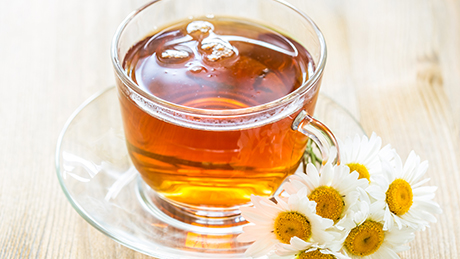
LATIN NAME: Matricaria chamomilla (L). (syn. Matricaria recutita (L.)
Chamomilla recutita (L.)
FAMILY: Asteraceae (daisy family)
COMMON NAMES: German chamomile, wild chamomile, chamomile, camomile USA). Not to be confused with Roman chamomile (Chamaemelum nobile), which can also be drunk as a tea.
PART USED: Flower heads which are dried to make the tea for the infusion.
KEY CONSTITUENTS: Essential oil (0.5-1.5%) including (-)-?-bisabolol, bisabolol oxides A, B and C, trans-en-yn-dicycloethers and matricine (only the distilled essential oil contains the blue compound chamazulene, which is a breakdown product of matricine during steam distillation); flavonoids (including apigenin) and bitter principals.
Chamomile is a daisy like plant which is often used in herb infusions to help induce sleep. It has traditionally been used for medicinal purposes and is one of the most popular single ingredients in herbal teas or tisanes.1 Chamomile also contains essential oil, including bisabolol and some of its salts, as well as flavonoids. It is one of the most popular teas in the world.
1 A review of the Bioactivity and Potential Health Benefits of Chamomile Tea by Diane L. McKay and Jeffrey B. Blumberg
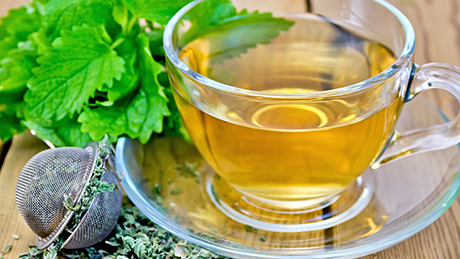
LATIN NAME: Melissa officinalis L
FAMILY: Lamiaceae (deadnettle family)
COMMON NAMES: Lemon balm, balm, bee balm
PART USED: Aerial parts. It is mainly the leaves used to make tea.
KEY CONSTITUENTS: Essential oil (0.02-0.3% w/w) including monoterpenes (citronellal, geranial and neral) and sesquiterpenes; phenolic acids (including rosmarinic acid) and flavonoids.
Traditionally, infusions of lemon balm have been drunk to help relieve mental stress and anxiety, aid sleep and to provide symptomatic relief of mild gastrointestinal complaints including bloating and flatulence.1 And a European Medicines Authority report confirmed these uses are “well documented in recognised handbooks”.2
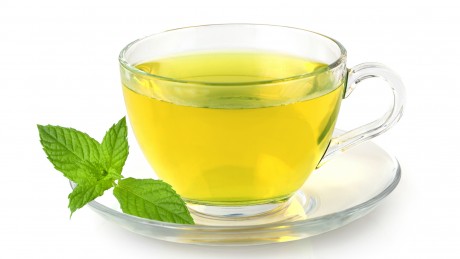
LATIN NAME: Mentha x piperita L
COMMON NAMES: Peppermint
FAMILY: Lamiaceae (deadnettle family)
PART USED: Leaf - the leaf is green with red veins
KEY CONSTITUENTS: Essential oil (0.5-4% w/w) consisting of mostly menthol (35-45%), (-)-menthone (10-30%), (+/-)-menthyl acetate, 1,8-cineole, limonene, beta-pinene, beta-caryophyllene, menthofuran, piperitone, jasmine (trace) and pulgenone; flavonoid tannins (6-12% w/w); triterpenes; and bitter principals.
One of the mint family of perennial herbs which grow throughout Europe, the peppermint is a hybrid cross between watermint and spearmint which spreads by rooting. Mint is rich in carotenes and vitamin C. It is also a good source of minerals including magnesium, copper, iron, potassium and calcium.1 Mint also contains menthol which helps to give mint tea a distinctive menthol taste.
Peppermint tea, brewed from the plant leaves has long been used in traditional medicines. The phenolic (plant chemical) compounds in the leaves include rosmarinic acid and several flavonoids, primarily eriocitrin, luteolin and hesperidin.2
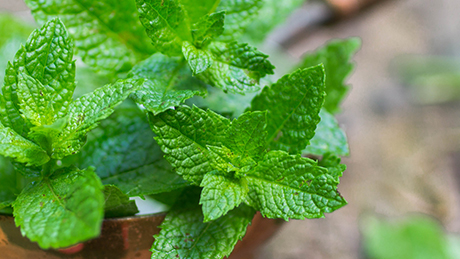
LATIN NAME: Mentha spicata L
COMMON NAMES: Spearmint, common mint, garden mint
FAMILY: Lamiaceae (deadnettle family)
PART USED: Leaf - spearmint is so named because of its pointy spear-like leaf
KEY CONSTITUENTS: Essential oil (1-4% w/w) including R-(–)-carvone, limonene, dihydrocarvone, and 1,8-cineol. Unlike peppermint essential oil, spearmint essential oil only contains minimal amounts of menthol and menthone; flavonoid tannins (6-12% w/w); triterpenes; and bitter principals.
Although it has a very similar aroma to peppermint, and shares many of the same digestive properties, spearmint contains a slightly different in balance of plant chemicals. Spearmint has less menthol than peppermint, but is rich in phyto (plant) chemicals such as limonene, dihydrocarvone and cineol.1 It has a distinctly aromatic, spearminty, mildly sweet flavour.
Spearmint contains antioxidant nutrients, including vitamin A, beta-carotene and vitamin C. It also provides folates and B vitamins, including riboflavin, thiamin and vitamin B6.2
1 http://www.medicalnewstoday.com/articles/266128.php
2 http://www.nutrition-and-you.com/spearmint.html Date from USDA Nutrient Database.
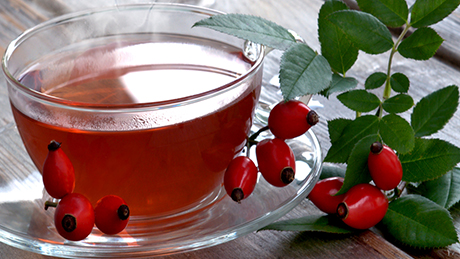
LATIN NAME: Rosa canina L., Rosa rubiginosa L. and Rosa rugosa Thunb
FAMILY: Rosaceae (rose family)
COMMON NAMES: Rosehip
PART USED: Fruit (hip) of the rose plant that is typically orange to red but can be purple to black in some species.
KEY CONSTITUENTS: Ascorbic acid (vitamin C), carotenoids (including beta-carotene, lutein, zeaxanthin and lycopene), polyphenols (such as proanthocyanidins), flavonoids (such as quercetin and catechin), unsaturated fatty acids and galactolipids such as GLGPG.
Rosehips which are the round part of the flower, just below the rose, have always been prized for their vitamin C content, although much of the vitamin is actually lost during drying. In addition to vitamin C, Rosehip tea contains flavonoids (such as quercetin and catechin), unsaturated fatty acids and galactolipids such as GLGPG.
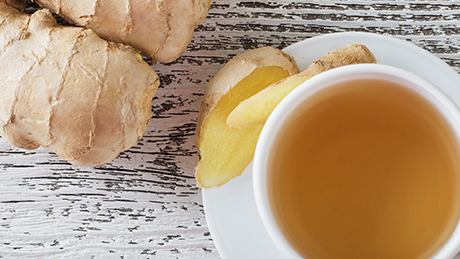
LATIN NAME: Zingiber officinale Rosc
COMMON NAMES: Ginger
FAMILY: Zingiberaceae (ginger family)
PART USED: Rhizome (ginger root)
KEY CONSTITUENTS: Essential oil (1-3% w/w) including monoterpenes (mostly geraniol and neral), sesquiterpenes (making up 30-70% of the essential oil - including beta-sesquiphellandrene, ar-curcumene, alpha-zingerberene and beta-bisabolene); pungent principals (4-7.5% w/w, including gingerols, shogaols and related phenolic ketone derivatives).
Beta-sesquiphellandrene and alpha-zingerberene are highest in fresh ginger and decompose on drying and storage. The gingerols gradually convert to shogaols on storage.
Ginger is a member of the Zingiberaceae family, alongside cardamom and turmeric and it has a long history of use to help relieve digestive problems, such as nausea, loss of appetite, motion sickness and morning sickness. It has recently been proposed that different combinations of antioxidants from tea and ginger blends could have synergistic effects.1
It is one of the oldest medicinal drinks in the world and has a distinctive, aromatic, spicy flavor. Although no longer grown wild, ginger originates in India where there are a huge number of genetic varieties.
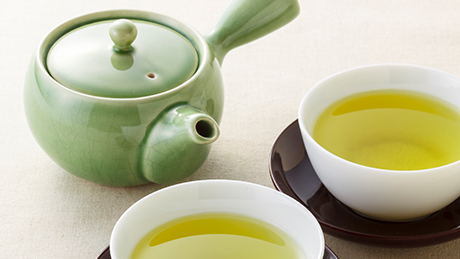
LATIN NAME: Camellia sinensis (L.) Kuntze
FAMILY: Theaceae (tea family)
COMMON NAMES: Green tea
PART USED: Tender leaves, buds and shoots of varieties of the species Camellia sinensis (L.) O. Kuntze, known to be suitable for making tea for consumption as a beverage (ISO 11287:2011)
KEY CONSTITUENTS: Flavonoids: flavonols: quercetin, kaempferol, myricetin mainly as 3-O-glycosides Flavones: apigenin, luteolin as C-glucuronides Flavanols: (flavan-3-ols 10-25%): (-)-epicatechin (EC), (epicatechin-3-O-gallate (ECG), (-)- epigallocatechin (EGC) and (-)-epigallocatechin-3-O-gallate (EGCG) Phenolic acids: including among others, chlorogenic acid, gallic acid, theogallin, amino acids: 19 amino acids, amongst which theanine [5-N-ethyl glutamine (3% w/w)], terpene saponins (theafolia saponins): aglycones including among others, barringtogenol C, R1- barringenol, polysaccharides (13 %) and proanthocyanidins (tannins).
Green tea is processed and grown in a variety of ways, depending on the type of green tea desired. As a result of these methods, maximum amounts of health promoting compounds are retained. Tea plants can be grown in the sun or in the shade and are grown in rows that are pruned to produce tender shoots in a regular manner. These shoots are then harvested as the climatic conditions allow e.g. in East Africa tea grows year-round in other locations such as Japan there are only 3 harvests per year.
Green tea processing should conform to the International Standard ISO 11287:2011 and be produced by acceptable processes, notably enzyme inactivation (typically pan-firing or steaming and commonly rolling or cutting, followed by drying.
Green tea is commonly consumed in Asia but was introduced into Europe in the 17th century. Traditionally, green tea has been used for the relief of fatigue and weakness, as a diuretic and for stomach disorders.1Green tea leaves have also been found to be an exceptionally abundant source of policosanol (PC), a mixture of bioactive long-chain aliphatic compounds.2